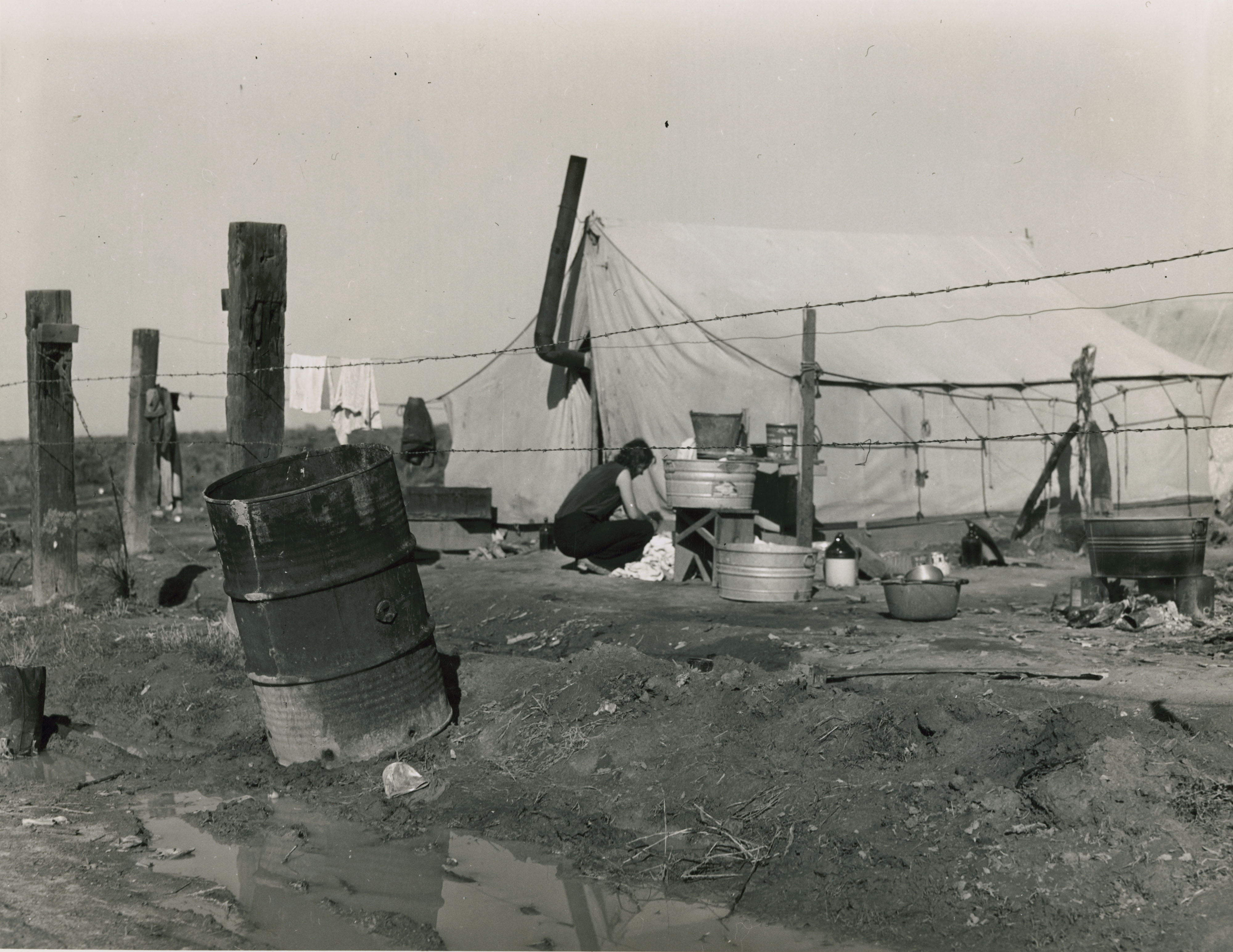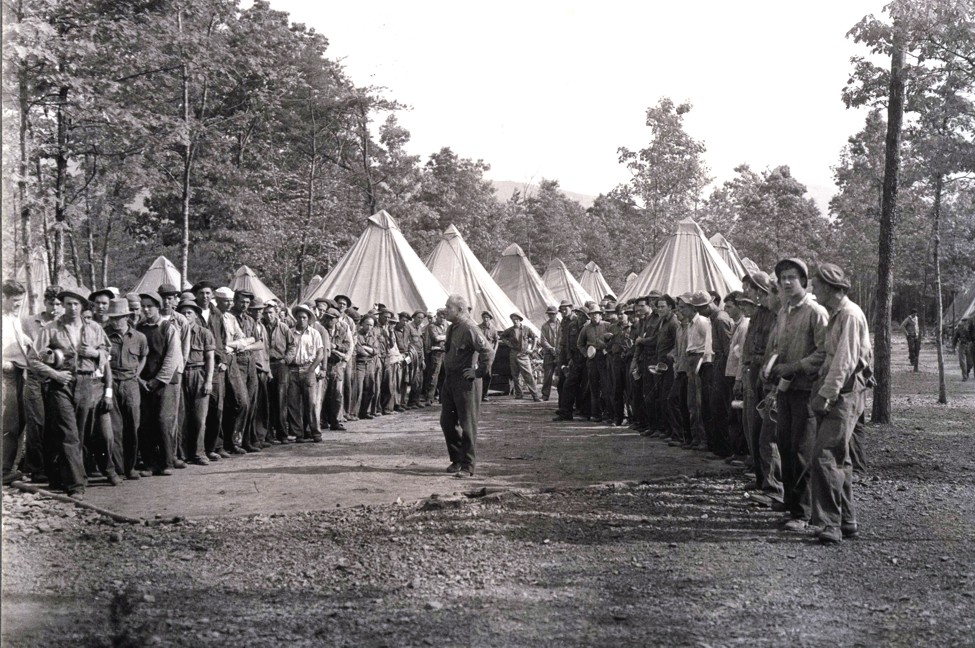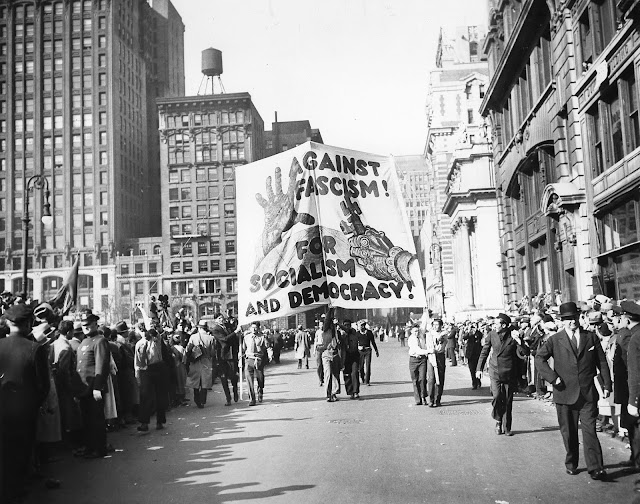"Shackles of the Regime"
“
… and as we went to bed, I passed a horrid sight–a boy, lucky to have been thirteen years old, hanging from the gallows, his eyes bulging out of his skull, tear tracts running down his face. Had he cried when he was being strung up, begged for mercy, or had it simply been the strangulation that did it? What crime could a boy have committed to have ended up in this place, let alone to deserve to be hanged? 'How can they do this? Where is God?' A man behind me quietly despaired. ‘He’s right there,’ my mind supplied, ‘Dangling from the gallows, still twitching.’" -Excerpt from John Glenn’s
Heartless in the Heartland
Early Natcorp forced labor
No aspect of the National-Corporate regime under Douglas MacArthur has been the subject of more study, debated, and collective horror than the web of labor, prison, and death camps that spanned its way across Natcorp-controlled America. These places emerged first out of necessity, and then, as the war progressed, out of a growing cruelty, as their functions shifted from detention and slave labor to liquidation of undesirables.
Under the purview of J. Edgar Hoover and the Department of Justice, the concentration camps first started in occupied territory, but, as dissent began to appear in the Natcorp homeland of the Upper South, they could soon be found in the remote regions of North Carolina, Tennessee, Kentucky, and Virginia. By the war’s end, the total number of encampments was forty-two, of which six were classified as death camps.
Of course, the use of slave labor was not restricted to just the camps. Many refugees who were evacuated by the regime from the countryside ended up in ghettoes in the hearts of industrial cities, and those who were able were usually put to work in factories vital to the war effort. Earlier in the war, this was usually compensated work, however, as the war situation deteriorated for the Natcorps, payment was first deferred, and then simply withheld entirely under the justification that payment to the refugees was given in the form of their rations and housing. Never mind the fact that the rations were insufficient and the housing was usually stolen from ethnic neighborhoods that had been cleaned out and their inhabitants put to work farming in the countryside in even worse conditions than the ghettoes.
The first camp was established just outside of Plymouth, Pennsylvania, a suburb of Wilkes-Barre, in response to the Natcorp capture of the city during the early days of the war. There, it held prisoners of war as well as local partisans. At this point, there were no plans for permanent detention, and many of the first detainees in Camp Plymouth were eventually released within weeks.
However, as the war deepened and local resistance to the regime sprung up wherever Natcorp boots tread, the need to contain that resistance proved overwhelming. Initial DOJ memos suggest that there was hope for some rehabilitation of the detainees, but this was quickly quashed, and plans soon shifted to essentially work those held in the camps to death, with certain exceptions. Even the legendarily callous Hoover believed that those who were underage could eventually reach a point where they would be able to be released.
It is a well-documented fact that the Natcorps pioneered the use of concentration camps in a way that was emulated by the Nazis during the Second World War. Though Dachau was established nearly a full year before the March on Washington, it was a markedly different type on encampment than those used in the United States by the Natcorps, being designed to hold political prisoners and only later becoming a concentration camp in the contemporary understanding of the word.
Throughout the war, nearly two million Americans ended up in the camps, though exact numbers are hard to quantify due to the staff and commanders often destroying records as the Republican Army approached their camps. Of that two million, approximately six hundred thousand people died, a third of which were the result of direct liquidation, while the other twothirds fell to malnutrition, injury, illness, or execution for any number of reasons or even no reason at all.
The six death camps built on Hoover’s direct orders were located in the following:
• Hempfield, Pennsylvania
• Salt Rock, West Virginia
• Akron, Ohio
• Kokomo, Indiana
• Rockfield, Illinois
• Marion, Iowa
Of these, the most brutal, resulting in nearly half of the two hundred thousand liquidations, was Camp Kokomo. Those brought into the camp were subjected to weapons tests and forms of torture that were explicitly designed to maximize human suffering. Under the purview of camp commandant Clyde Barrow, Kokomo became a factory of death that revolted even the most hardened of Hoover’s G-Men, to the point that the camp’s existence was stricken even from the Director’s personal records.
New arrivals to Camp Kokomo
Barrow and his long-time companion and later wife, Bonnie Parker, have endured in the American psyche as symptoms of the moral rot that pervaded the Natcorps from top to bottom. Indeed, their story is one that is rather unusual, because Bonnie and Clyde started out as petty criminals and the subject of some measure of public adoration. The pair, part of a wider gang, were famous for robbing banks and grocery stores across Texas in the early 1930’s, before moving on to more serious crimes.
By early 1934, the two crooks had death warrants on their heads, and made plans to flee from the newly-empowered Texas Rangers under the quasi-government of Huey Long. They were able to make it as far north as Missouri before being caught at a checkpoint in Jefferson City in March. Rather than attempt to fight against the military, the two surrendered, and soon found themselves presented with a choice–make themselves useful to General MacArthur or face the firing squad.
Initially, the two were put to work processing POWs in central Illinois before being transferred to guarding a refugee filtration center outside of Columbus, Ohio. Barrow and Parker both proved to be able, if sadistic, guards. Parker in particular was found to be useful, as her penchant for writing poetry translated to her transferral into the bureaucratic side of things. In order to prevent their separation, the pair wed in August of 1935.
In September of 1935, the two were moved to Camp Kokomo, then under the management of the former United States Attorney for the Southern District of Indiana, Val Nolan. Nolan soon found himself eliminated from the position for his refusal to carry out the sort of industrialized death the camp was designed for, and Barrow was recommended for the job of commandant by his former supervisor in Ohio.
Clyde Barrow and Bonnie Marker, 1933-1932
Under Barrow’s purview, what little camp documentation survives paints an image as stark as those of the gas chambers of Auschwitz or the depravities perpetrated by Japan’s Unit 731. The few survivors of Camp Kokomo, mostly those liberated from the camp following its capture, specifically reference Barrow’s personal sadism.
The role of Bonnie Parker in the running of Kokomo is heavily debated, especially due to the limited number of surviving documents. Testaments vary immensely, some suggesting she had little to do with the actual operations of the camp, and others putting her directly at the center. One survivor alleged that she personally took part in his torture, and this quickly snowballed into a public narrative of Parker as sexually voracious torturer who manipulated her husband and used the camp as her personal playground of horror. This was patently false, but it still exists today in the frequent usage of the slang term ‘Kokomo Queen’ to refer to a cruel, promiscuous woman with little regard for the men she harms.
The tale of Bonnie and Clyde came to its bloody conclusion as the war neared its end. With the Republican military bearing down on Camp Kokomo, the commandant and his wife abandoned their post after overseeing the destruction of most of the camp’s records and the execution of most of the few remaining prisoners. The two were attempting to flee to Canada with falsified documents, but were discovered while attempting to cross a bridge in Chippewa Falls, Wisconsin. Barrow, driving their town car, sped off, but both were killed when the Republican soldiers at the checkpoint riddled the vehicle with bullets.
Beyond the death camps were the work camps, which were often located directly in key industrial centers. At times, free factory workers intermingled with those who were subjected to forced labor, but this practice soon died out as conditions in the work camps decayed and the people enslaved there became too emaciated to be allowed to be seen by the general public.
A Natcorp factory in Springfield, Illinois
Conditions varied wildly from place to place, depending on the type of work being done and proximity to the fighting, as well as other factors. On average, work camps saw a death rate in the range of ten to twenty percent, with outliers as low as the single digits and as high as more than fifty percent. The largest Natcorp work camp was Camp Vinton, located outside of Cedar Rapids, Iowa. There, as many as forty thousand men and women were enslaved to farm corn and wheat for the regime. Ironically, Camp Vinton saw an excessively high mortality rate due to malnutrition, as virtual none of its produce was kept to feed the people working it.
The first people in the Natcorp concentration camps were prisoners of war and partisans. They were soon joined by political opponents to the regime, and then by a growing list of undesirable minorities. These included Catholics, Jews, the Amish, homosexuals, and any number of ethnic and racial minorities. Unlike Nazi policies, which called for the rounding up of undesirables regardless of whether or not they’d committed any crimes, the regime was mostly content to supervise these groups intently, waiting for even the slightest slip in behavior. When the decision to seize someone was made, it was carried out swiftly and brutally, and collateral casualties often followed the G-Men’s raids.
Special note should be made of the African American population across the Midwest. Prior to the war, the Black population of the United States had been undergoing a process known as the Great Migration, which saw large numbers of Black families moving northward from the South due to economic and social conditions. In the North, segregation was not as direct as Jim Crow in the South, but rather a de facto practice caused by self-sorting and discriminatory housing practices.
This changed with the dawn of the National-Corporate regime. Almost immediately, Black workers saw wages slashed and the number of jobs available to them sharply decreased. Within months of MacArthur coming to power, an even fiercer form of segregation had taken a stranglehold across much of the Midwest due to the Natcorp military occupation. The movement of Black people was heavily regulated, being restricted to their own, separate ghettoes in most cities, and those in the suburbs and rural areas were cleared out, with their properties being transferred to White families.
Even the labor camps for African Americans were segregated, and they were the subject to the regime’s most pointed neglect. Moreover, the regime was much more likely to simply execute a Black offender rather than move them into a camp to begin with, meaning that those in the segregated camps were almost always low-level offenders who otherwise would have been fined or given a limited sentence of supervised, unpaid labor.
Segregation, brought by the Natcorps to Ohio
Immigrants also suffered unique injustices under the regime. Cultural practices and dress that the regime deemed “un-American” were harshly curbed, and the use of languages other than English was essentially forbidden in public. Many immigrant families could not properly register with the Natcorps due to the forms being only provided in English, which resulted in them being denied rations and resettlement, or even being falsely accused of being subversive agents for the Republic and imprisoned.
As the full scope of the Natcorp atrocities became public knowledge across the United States and the world, outrage bloomed, even in MacArthur’s personal fiefdom in Washington. As the war entered its twilight, the only world governments which had not recognized Albany as the legitimate authority in America were Italy and Germany, but even they had begun to scale down their support for the National-Corporate government by this point.
Historians debate the effectiveness of the concentration camp system in Natcorp America. Brooks argues that the amount of weapons and ammunition produced in the camps made them an effective investment in the eyes of the bureaucratic aspect of the regime despite their horrors, while Rummel counters with the point that many of those imprisoned and killed might have otherwise been willing contributors to the cause had Hoover simply tolerated minor amounts of dissent that would have likely gone nowhere provided those dissenting felt heard and protected by the regime.
The existence of the camps in a large war zone meant that escape was especially rare, and those who few who made it out, already weakened from malnutrition, illness, and injury, found themselves in a desolate landscape of scarce resources and danger around every corner. In just under fifteen hundred escapes, one hundred and seventy four people successfully found their way to safe harbor in the Republic or in Canada.
The official count of survivors liberated from the camps by the end of the war is posted at 1,345,702. These people, many of whom were gravely ill or facing starvation, constituted a full percentage of the prewar population. By 2020, the number of survivors had dwindled to less than five thousand, most of whom had been children during their imprisonment. Among those who survived and went on to become famous were astronaut and politician John Glenn, Star Trek actress Majel Barrett, Illinois governor Adlai Stevenson II, and musician Perry Como.
Ultimately, the operators of the concentration camp network made up a large portion of those who were subject to the military tribunals of the Cincinnati Trials, the overwhelming majority of whom were convicted and sentenced to death, meeting their fates in an event that is now subject to intense debate, the infamous Gallows Day.
Anti-fascist demonstrators in New York City






